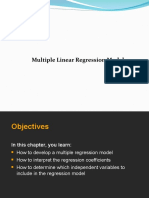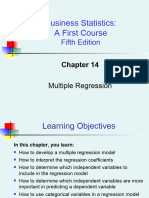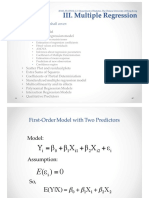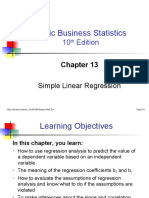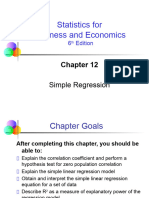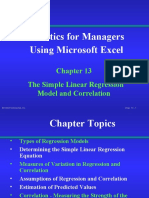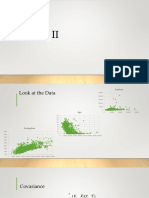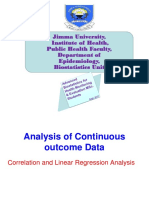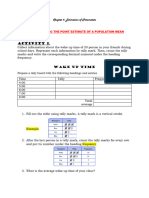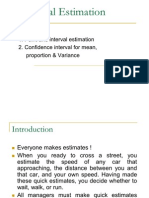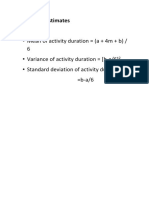Statistics Industry
Chapter 13
Multiple Regression
Statistics for Business and Economics, 6e 2007 Pearson Education, Inc.
Chap 13-1
�The Multiple Regression
Model
Idea: Examine the linear relationship between
1 dependent (Y) & 2 or more independent variables (Xi)
Multiple Regression Model with k Independent Variables:
Y-intercept
Population slopes
Random Error
Y 0 1X1 2 X2 k Xk
Statistics for Business and Economics, 6e 2007 Pearson Education, Inc.
Chap 13-2
�Multiple Regression Equation
The coefficients of the multiple regression model are
estimated using sample data
Multiple regression equation with k independent variables:
Estimated
(or predicted)
value of y
Estimated
intercept
Estimated slope coefficients
y i b0 b1x1i b2 x2i bk xki
In this chapter we will always use a computer to obtain the
regression slope coefficients and other regression
summary measures.
Statistics for Business and Economics, 6e 2007 Pearson Education, Inc.
Chap 13-3
�Multiple Regression Equation
(continued)
Two variable model
y b0 b1x1 b2 x2
x2
x1
Statistics for Business and Economics, 6e 2007 Pearson Education, Inc.
Chap 13-4
�Standard Multiple Regression
Assumptions
The values xi and the error terms i are
independent
The error terms are random variables with
mean 0 and a constant variance, 2.
E[i ] 0 and E[i2 ] 2
for (i 1, ,n)
(The constant variance property is called
homoscedasticity)
Statistics for Business and Economics, 6e 2007 Pearson Education, Inc.
Chap 13-5
�Standard Multiple Regression
Assumptions
(continued)
The random error terms, i , are not correlated
with one another, so that
E[ i j ] 0
for all i j
It is not possible to find a set of numbers, c0,
c1, . . . , ck, such that
c0 c1x1i c 2 x2i cK xKi 0
(This is the property of no linear relation for
the Xjs)
Statistics for Business and Economics, 6e 2007 Pearson Education, Inc.
Chap 13-6
�Example:
2 Independent Variables
A distributor of frozen desert pies wants to
evaluate factors thought to influence demand
Dependent variable:
Pie sales (units per week)
Independent variables: Price (in $)
Advertising ($100s)
Data are collected for 15 weeks
Statistics for Business and Economics, 6e 2007 Pearson Education, Inc.
Chap 13-7
�Pie Sales Example
Week
Pie
Sales
Price
($)
Advertising
($100s)
350
5.50
3.3
460
7.50
3.3
350
8.00
3.0
430
8.00
4.5
350
6.80
3.0
380
7.50
4.0
430
4.50
3.0
470
6.40
3.7
450
7.00
3.5
10
490
5.00
4.0
11
340
7.20
3.5
12
300
7.90
3.2
13
440
5.90
4.0
14
450
5.00
3.5
15
300
7.00
2.7
Multiple regression equation:
Statistics for Business and Economics, 6e 2007 Pearson Education, Inc.
Sales = b0 + b1 (Price)
+ b2 (Advertising)
Chap 13-8
�Estimating a Multiple Linear
Regression Equation
Excel will be used to generate the coefficients
and measures of goodness of fit for multiple
regression
Excel:
Tools / Data Analysis... / Regression
PHStat:
PHStat / Regression / Multiple Regression
Statistics for Business and Economics, 6e 2007 Pearson Education, Inc.
Chap 13-9
�Multiple Regression Output
Regression Statistics
Multiple R
0.72213
R Square
0.52148
Adjusted R Square
0.44172
Standard Error
47.46341
Observations
ANOVA
Regression
Sales 306.526 - 24.975(Price) 74.131(Advertising)
15
df
SS
MS
29460.027
14730.013
Residual
12
27033.306
2252.776
Total
14
56493.333
Coefficients
Standard Error
Intercept
306.52619
114.25389
2.68285
0.01993
57.58835
555.46404
Price
-24.97509
10.83213
-2.30565
0.03979
-48.57626
-1.37392
74.13096
25.96732
2.85478
0.01449
17.55303
130.70888
Advertising
Statistics for Business and Economics, 6e 2007 Pearson Education, Inc.
t Stat
6.53861
Significance F
P-value
0.01201
Lower 95%
Upper 95%
Chap 13-10
�The Multiple Regression Equation
Sales 306.526 - 24.975(Price) 74.131(Advertising)
where
Sales is in number of pies per week
Price is in $
Advertising is in $100s.
b1 = -24.975: sales
will decrease, on
average, by 24.975
pies per week for
each $1 increase in
selling price, net of
the effects of changes
due to advertising
Statistics for Business and Economics, 6e 2007 Pearson Education, Inc.
b2 = 74.131: sales will
increase, on average,
by 74.131 pies per
week for each $100
increase in
advertising, net of the
effects of changes
due to price
Chap 13-11
�Coefficient of Determination, R2
Reports the proportion of total variation in y
explained by all x variables taken together
SSR regressionsum of squares
R
SST
total sum of squares
2
This is the ratio of the explained variability to
total sample variability
Statistics for Business and Economics, 6e 2007 Pearson Education, Inc.
Chap 13-12
�Coefficient of Determination, R2
(continued)
Regression Statistics
Multiple R
0.72213
R Square
0.52148
Adjusted R Square
0.44172
Standard Error
Regression
52.1% of the variation in pie sales
is explained by the variation in
price and advertising
47.46341
Observations
ANOVA
SSR 29460.0
R
.52148
SST 56493.3
2
15
df
SS
MS
29460.027
14730.013
Residual
12
27033.306
2252.776
Total
14
56493.333
Coefficients
Standard Error
Intercept
306.52619
114.25389
2.68285
0.01993
57.58835
555.46404
Price
-24.97509
10.83213
-2.30565
0.03979
-48.57626
-1.37392
74.13096
25.96732
2.85478
0.01449
17.55303
130.70888
Advertising
Statistics for Business and Economics, 6e 2007 Pearson Education, Inc.
t Stat
6.53861
Significance F
P-value
0.01201
Lower 95%
Upper 95%
Chap 13-13
�Estimation of Error Variance
Consider the population regression model
Yi 0 1x1i 2 x 2i K xKi i
The unbiased estimate of the variance of the errors is
n
2
e
i
SSE
s
n K 1 n K 1
2
e
i1
where ei yi y i
The square root of the variance, se , is called the
standard error of the estimate
Statistics for Business and Economics, 6e 2007 Pearson Education, Inc.
Chap 13-14
�Standard Error, se
Regression Statistics
Multiple R
0.72213
R Square
0.52148
Adjusted R Square
0.44172
Standard Error
Regression
The magnitude of this
value can be compared to
the average y value
47.46341
Observations
ANOVA
se 47.463
15
df
SS
MS
29460.027
14730.013
Residual
12
27033.306
2252.776
Total
14
56493.333
Coefficients
Standard Error
Intercept
306.52619
114.25389
2.68285
0.01993
57.58835
555.46404
Price
-24.97509
10.83213
-2.30565
0.03979
-48.57626
-1.37392
74.13096
25.96732
2.85478
0.01449
17.55303
130.70888
Advertising
Statistics for Business and Economics, 6e 2007 Pearson Education, Inc.
t Stat
6.53861
Significance F
P-value
0.01201
Lower 95%
Upper 95%
Chap 13-15
�Adjusted Coefficient of
Determination, R 2
R2 never decreases when a new X variable is
added to the model, even if the new variable is
not an important predictor variable
This can be a disadvantage when comparing
models
What is the net effect of adding a new variable?
We lose a degree of freedom when a new X
variable is added
Did the new X variable add enough
explanatory power to offset the loss of one
degree of freedom?
Statistics for Business and Economics, 6e 2007 Pearson Education, Inc.
Chap 13-16
�Adjusted Coefficient of
Determination, R 2
(continued)
Used to correct for the fact that adding non-relevant
independent variables will still reduce the error sum of
squares
SSE / (n K 1)
R 1
SST / (n 1)
2
(where n = sample size, K = number of independent variables)
Adjusted R2 provides a better comparison between
multiple regression models with different numbers of
independent variables
Penalize excessive use of unimportant independent
variables
Smaller than R2
Statistics for Business and Economics, 6e 2007 Pearson Education, Inc.
Chap 13-17
�R
Regression Statistics
Multiple R
0.72213
R Square
0.52148
Adjusted R Square
0.44172
Standard Error
47.46341
Observations
ANOVA
Regression
15
df
R .44172
2
44.2% of the variation in pie sales is
explained by the variation in price and
advertising, taking into account the sample
size and number of independent variables
SS
MS
29460.027
14730.013
Residual
12
27033.306
2252.776
Total
14
56493.333
Coefficients
Standard Error
Intercept
306.52619
114.25389
2.68285
0.01993
57.58835
555.46404
Price
-24.97509
10.83213
-2.30565
0.03979
-48.57626
-1.37392
74.13096
25.96732
2.85478
0.01449
17.55303
130.70888
Advertising
Statistics for Business and Economics, 6e 2007 Pearson Education, Inc.
t Stat
6.53861
Significance F
P-value
0.01201
Lower 95%
Upper 95%
Chap 13-18
�Coefficient of Multiple
Correlation
The coefficient of multiple correlation is the correlation
between the predicted value and the observed value of
the dependent variable
R r(y , y) R2
Is the square root of the multiple coefficient of
determination
Used as another measure of the strength of the linear
relationship between the dependent variable and the
independent variables
Comparable to the correlation between Y and X in
simple regression
Statistics for Business and Economics, 6e 2007 Pearson Education, Inc.
Chap 13-19
�Evaluating Individual
Regression Coefficients
Use t-tests for individual coefficients
Shows if a specific independent variable is
conditionally important
Hypotheses:
H0: j = 0 (no linear relationship)
H1: j 0 (linear relationship does exist
between xj and y)
Statistics for Business and Economics, 6e 2007 Pearson Education, Inc.
Chap 13-20
�Evaluating Individual
Regression Coefficients
(continued)
H0: j = 0 (no linear relationship)
H1: j 0 (linear relationship does exist
between xi and y)
Test Statistic:
bj 0
t
Sb j
Statistics for Business and Economics, 6e 2007 Pearson Education, Inc.
(df = n k 1)
Chap 13-21
�Evaluating Individual
Regression Coefficients
(continued)
Regression Statistics
Multiple R
0.72213
R Square
0.52148
Adjusted R Square
0.44172
Standard Error
47.46341
Observations
ANOVA
Regression
15
df
t-value for Price is t = -2.306, with
p-value .0398
t-value for Advertising is t = 2.855,
with p-value .0145
SS
MS
29460.027
14730.013
Residual
12
27033.306
2252.776
Total
14
56493.333
Coefficients
Standard Error
Intercept
306.52619
114.25389
2.68285
0.01993
57.58835
555.46404
Price
-24.97509
10.83213
-2.30565
0.03979
-48.57626
-1.37392
74.13096
25.96732
2.85478
0.01449
17.55303
130.70888
Advertising
Statistics for Business and Economics, 6e 2007 Pearson Education, Inc.
t Stat
6.53861
Significance F
P-value
0.01201
Lower 95%
Upper 95%
Chap 13-22
�Example: Evaluating Individual
Regression Coefficients
From Excel output:
H0: j = 0
H1: j 0
Price
Advertising
d.f. = 15-2-1 = 12
= .05
Coefficients
Standard Error
t Stat
P-value
-24.97509
10.83213
-2.30565
0.03979
74.13096
25.96732
2.85478
0.01449
The test statistic for each variable falls
in the rejection region (p-values < .05)
t12, .025 = 2.1788
Decision:
/2=.025
/2=.025
Reject H0 for each variable
Conclusion:
Reject H0
Do not reject H0
-t/2
-2.1788
Reject H0
t/2
2.1788
Statistics for Business and Economics, 6e 2007 Pearson Education, Inc.
There is evidence that both
Price and Advertising affect
pie sales at = .05
Chap 13-23
�Confidence Interval Estimate
for the Slope
Confidence interval limits for the population slope j
b j tnK 1,/2Sb j
Coefficients
Standard Error
Intercept
306.52619
114.25389
Price
-24.97509
10.83213
74.13096
25.96732
Advertising
where t has
(n K 1) d.f.
Here, t has
(15 2 1) = 12 d.f.
Example: Form a 95% confidence interval for the effect of
changes in price (x1) on pie sales:
-24.975 (2.1788)(10.832)
So the interval is
Statistics for Business and Economics, 6e 2007 Pearson Education, Inc.
-48.576 < 1 < -1.374
Chap 13-24
�Confidence Interval Estimate
for the Slope
(continued)
Confidence interval for the population slope i
Coefficients
Standard Error
Intercept
306.52619
114.25389
57.58835
555.46404
Price
-24.97509
10.83213
-48.57626
-1.37392
74.13096
25.96732
17.55303
130.70888
Advertising
Lower 95%
Upper 95%
Example: Excel output also reports these interval endpoints:
Weekly sales are estimated to be reduced by between 1.37 to
48.58 pies for each increase of $1 in the selling price
Statistics for Business and Economics, 6e 2007 Pearson Education, Inc.
Chap 13-25
�Test on All Coefficients
F-Test for Overall Significance of the Model
Shows if there is a linear relationship between all
of the X variables considered together and Y
Use F test statistic
Hypotheses:
H0: 1 = 2 = = k = 0 (no linear relationship)
H1: at least one i 0 (at least one independent
variable affects Y)
Statistics for Business and Economics, 6e 2007 Pearson Education, Inc.
Chap 13-26
�F-Test for Overall Significance
Test statistic:
MSR
SSR/K
F 2
se
SSE/(n K 1)
where F has k (numerator) and
(n K 1) (denominator)
degrees of freedom
The decision rule is
Reject H0 if F Fk,nK 1,
Statistics for Business and Economics, 6e 2007 Pearson Education, Inc.
Chap 13-27
�F-Test for Overall Significance
(continued)
Regression Statistics
Multiple R
0.72213
R Square
0.52148
Adjusted R Square
0.44172
Standard Error
47.46341
Observations
ANOVA
Regression
15
df
MSR 14730.0
F
6.5386
MSE 2252.8
With 2 and 12 degrees
of freedom
SS
MS
P-value for
the F-Test
F
29460.027
14730.013
Residual
12
27033.306
2252.776
Total
14
56493.333
Coefficients
Standard Error
Intercept
306.52619
114.25389
2.68285
0.01993
57.58835
555.46404
Price
-24.97509
10.83213
-2.30565
0.03979
-48.57626
-1.37392
74.13096
25.96732
2.85478
0.01449
17.55303
130.70888
Advertising
Statistics for Business and Economics, 6e 2007 Pearson Education, Inc.
t Stat
6.53861
Significance F
P-value
0.01201
Lower 95%
Upper 95%
Chap 13-28
�F-Test for Overall Significance
(continued)
H0: 1 = 2 = 0
H1: 1 and 2 not both zero
= .05
df1= 2
df2 = 12
Critical
Value:
= .05
Do not
reject H0
Reject H0
MSR
F
6.5386
MSE
Decision:
Since F test statistic is in
the rejection region (pvalue < .05), reject H0
F = 3.885
Test Statistic:
Conclusion:
F
F.05 = 3.885
Statistics for Business and Economics, 6e 2007 Pearson Education, Inc.
There is evidence that at least one
independent variable affects Y
Chap 13-29
�Tests on a Subset of
Regression Coefficients
Consider a multiple regression model involving
variables xj and zj , and the null hypothesis that the z
variable coefficients are all zero:
yi 0 1x1i K xKi 1z1i r zri i
H0 : 1 2 r 0
H1 : at least one of j 0 (j 1,..., r)
Statistics for Business and Economics, 6e 2007 Pearson Education, Inc.
Chap 13-30
�Tests on a Subset of
Regression Coefficients
(continued)
Goal: compare the error sum of squares for the
complete model with the error sum of squares for the
restricted model
First run a regression for the complete model and obtain SSE
Next run a restricted regression that excludes the z variables
(the number of variables excluded is r) and obtain the
restricted error sum of squares SSE(r)
Compute the F statistic and apply the decision rule for a
significance level
( SSE(r) SSE ) / r
Reject H0 if F
Fr,nK r 1,
2
se
Statistics for Business and Economics, 6e 2007 Pearson Education, Inc.
Chap 13-31
�Prediction
Given a population regression model
yi 0 1x1i 2 x 2i K xKi i (i 1,2,,n)
then given a new observation of a data point
(x1,n+1, x 2,n+1, . . . , x K,n+1)
the best linear unbiased forecast of ^yn+1 is
y n1 b0 b1x1,n1 b2 x 2,n1 bK xK,n1
It is risky to forecast for new X values outside the range of the data used
to estimate the model coefficients, because we do not have data to
support that the linear model extends beyond the observed range.
Statistics for Business and Economics, 6e 2007 Pearson Education, Inc.
Chap 13-32
�Using The Equation to Make
Predictions
Predict sales for a week in which the selling
price is $5.50 and advertising is $350:
Sales 306.526 - 24.975(Price) 74.131(Advertising)
306.526 - 24.975 (5.50) 74.131(3.5)
428.62
Predicted sales
is 428.62 pies
Statistics for Business and Economics, 6e 2007 Pearson Education, Inc.
Note that Advertising is
in $100s, so $350
means that X2 = 3.5
Chap 13-33
�Predictions in PHStat
PHStat | regression | multiple regression
Check the
confidence and
prediction interval
estimates box
Statistics for Business and Economics, 6e 2007 Pearson Education, Inc.
Chap 13-34
�Predictions in PHStat
(continued)
Input values
<
Predicted y value
<
Confidence interval for the
mean y value, given
these xs
<
Prediction interval for an
individual y value, given
these xs
Statistics for Business and Economics, 6e 2007 Pearson Education, Inc.
Chap 13-35
�Residuals in Multiple Regression
Two variable model
y b0 b1x1 b2 x2
<
Residual =
ei = (yi yi)
yi
Sample
observation
<
yi
x2i
x2
x1i
x1
Statistics for Business and Economics, 6e 2007 Pearson Education, Inc.
Chap 13-36
�Statistics for Business and Economics, 6e 2007 Pearson Education, Inc.
Chap 13-37




